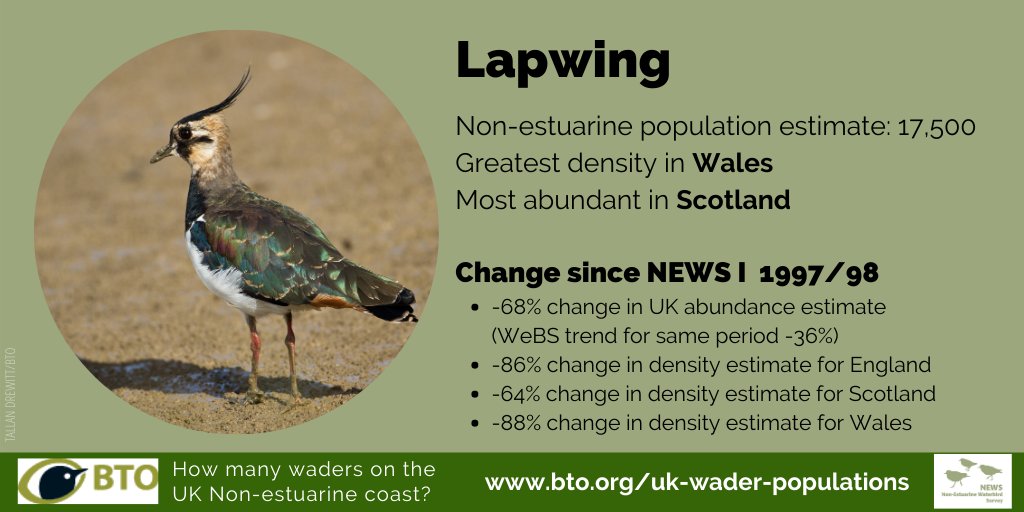
The results for waders from the 2015/16 Non-Estuarine Waterbird Survey, NEWS III, have just been published in the @_BTO journal Bird Study. Most of the wader species of the open coast are declining. Let’s take a closer look at some of the results ⬇️ #WeBSOnRocks #BTOScience 1/13 

The most abundant wader in the 2015/16 NEWS III survey of the open coast was Oystercatcher. Average density was highest on the Welsh non-estuarine coast. #WeBSOnRocks 2/13 

A high proportion of Ringed Plover in mid-winter use the non-estuarine coast. Analysis of density on stretches also counted in the earlier non-estuarine surveys indicated a density reduction of 72% in England. #WeBSOnRocks 3/13 

Most waders had their largest open coast populations on the Scottish coast, but Grey Plover has an easterly distribution, and half the estimated 1,000 non-estuarine population was in England. #WeBSOnRocks 4/13 

Lapwing uses many habitats in winter, but seems to have had a large decline in the population using habitats around the coast compared to NEWS I in 1997/98. #WeBSOnRocks 5/13 

Sanderling bucked the trend, with increases in the density estimates for coastal stretches in England, Scotland and Wales. The upwards trend was more pronounced than that captured by WeBS, which only includes a small fraction of open coast sites. #WeBSOnRocks 6/13 

A specialist of the non-estuarine coast, over nine out of ten of the 10,200 Purple Sandpiper were in Scotland, where there were density declines. More encouragingly, English stretches resurveyed had an average increase in density. #WeBSOnRocks 7/13 

Dunlin may be declining faster on the non-estuarine coast compared to estuaries, as the UK NEWS estimate halved from NEWS I, whereas the WeBS trend had dropped by 38% over the same period. #WeBSOnRocks 8/13 

Results were mixed for Bar-tailed Godwit, with a large decline in the density estimates between the NEWS I and NEWS III surveys for England, but an increase in Scotland. #WeBSOnRocks 9/13 

Curlew is declining faster on the non-estuarine coast than on estuaries, with the open coast holding about a third of the wintering population. This could be related to the differing winter distributions of breeding populations from the UK and other countries. #WeBSOnRocks 10/13 

Redshank is also exhibiting a faster decline on the non-estuarine coast as measured by NEWS (-42%) to that measured by the WeBS trend, which is biased towards estuaries. The density estimate for Scotland halved and reduced by 64% for England. #WeBSOnRocks 11/13 

Winter Turnstone, another iconic bird of the non-estuarine coast, also saw declines in England and Scotland. NEWS III has given us crucial insight into the use of the non-estuarine coast by tens of thousands of Turnstone and other wintering waders. #WeBSOnRocks 12/13 

Read more at bto.org/uk-wader-popul…; paper at bit.ly/NEWSpaper (not open access); research report at bit.ly/NEWSreport. Our grateful thanks to the funders & volunteers in NEWS III and earlier surveys who made this study possible. #WeBSOnRocks 13/13 

• • •
Missing some Tweet in this thread? You can try to
force a refresh


